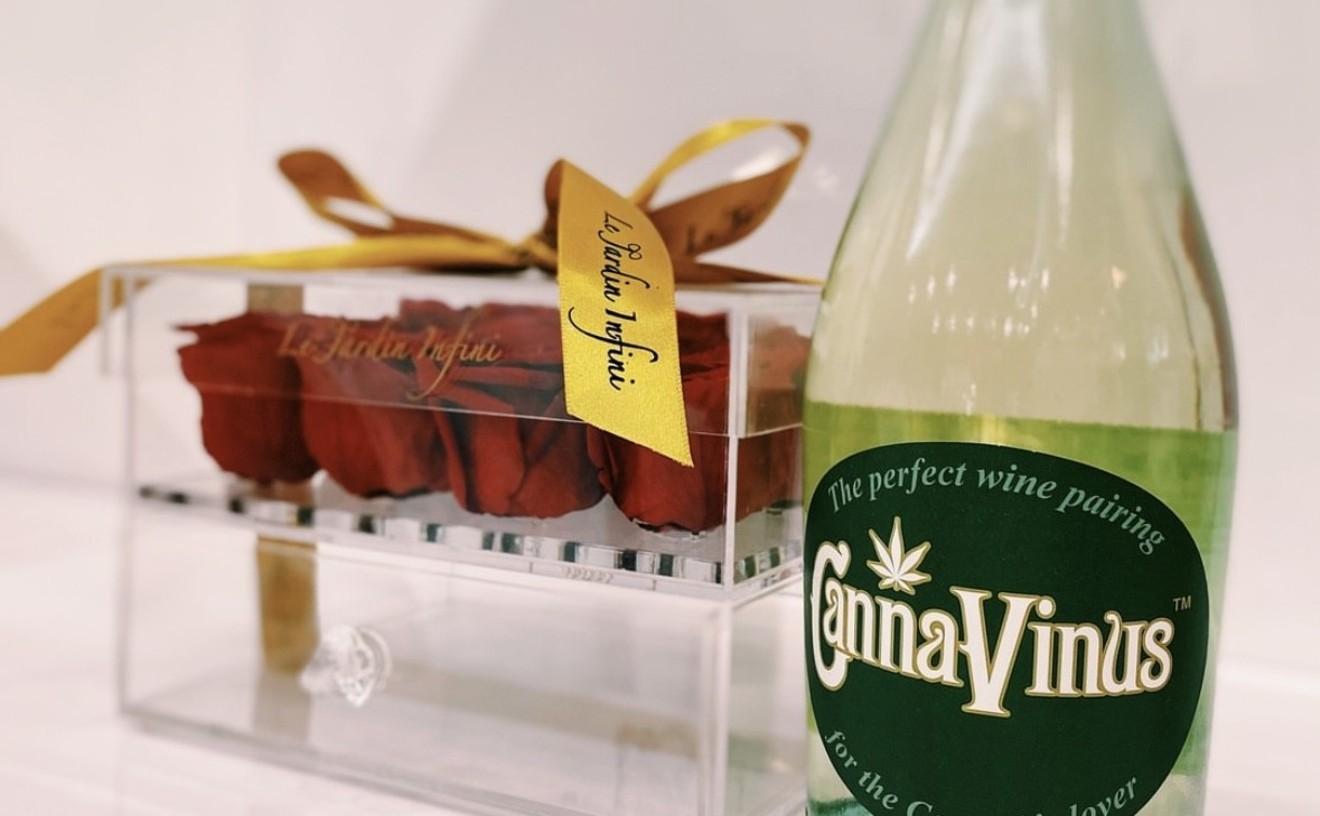By the time your server has finished telling you the philosophy behind the Kuro menu, you might stop wondering why you're about to pay $24 for a tower of toro the size of a Ping-Pong ball. It's a tasty, beautiful pile of toro, fatty and rich, paired with a trio of sauces — salty, spicy, and sweet — served as an interactive dish that comes with a basket of crispy wontons fried into pillow-shaped balloons. The dish is marvelously delicate, but it's also a lot less food than you might be expecting.
Kuro offers a traditional, multicourse Japanese style of dining known as kaiseki.
tweet this
You'll only need to hear the server's lengthy Kuro introduction once to understand what's happening at the Seminole Hard Rock Hotel & Casino's new-style Japanese restaurant. Although there are many ways to nosh on sushi and sashimi in Broward County, that's not all you'll find here. Instead, the entire operation approaches each meal with so much ardor, you can't help but be swept away by their enthusiasm.
That energy is the impetus behind the Hollywood resort's latest dining concept, designed bottom to top by a new management team including Hard Rock's vice president of food and beverage, Justin Wyborn, and creative culinary director Alex Becker. The goal: to create an upmarket establishment unlike any other in Broward County — or South Florida, for that matter.
"Think of it as a roller-coaster ride for your senses, an interactive dining experience that takes you through a series of dishes from light to heavy and back again," explains Becker.
To that end, Kuro — Japanese for "black" — has become the resort's new 9,500-square-foot showpiece, a custom-designed theater-style dining room set with booths and circular tables each presenting a clear view of the restaurant's impressive open kitchen. Up a short flight of steps and past a massive, shell-encrusted column, Kuro opens with a lounge and bar lit beneath a dome-shaped skylight and floor-to-ceiling windows overlooking the resort's tropical-themed pool oasis beyond. The establishment showcases a neutral palette — a golden-toned sea of bronze, beige, and white married with natural stone, woods, and water elements.
But don't expect to find boats of sashimi or sushi rolls with catchy names. Rather, Kuro offers Becker's take on the traditional, multicourse Japanese style of dining known as kaiseki, a word used to describe a series of meals that progress from light, simple fare to heavier, more complex dishes.
In the United States, you might be tempted to compare it to a tasting menu, that procession of sample-sized servings often accompanied by minute-long dissertations on flavors and ingredients. At Kuro, the kaiseki-style experience is less about pomp, and more about sharing. The idea is to offer a menu where no two dining experiences are alike, each tailored to a patron's specific likes and preferences, with enough options to provide a different gastronomic journey on every visit.
Here, patrons can dine in a variety of settings, from the ten-seat sushi bar to a private chef's omakase table that offers a front-row to the restaurant's multi-station kitchen. Dinner parties can retreat to one of two private dining areas, including a glass-walled room that overlooks the main dining area on one side and the hallway leading into the casino lobby on the other. Outside, just steps from Kuro's lounge, two private tables allow for a quiet alfresco dinner beside the pool.
Not every seat in the house will offer such a view, but there's one thing they all share: Attention to detail. There are so many whimsical touches here, it's easy to be seduced, from a menu delivered as a large, leather-bound book; hand-carved chopstick holders; and your own personal gastronomic guide.
Service is a focal point at Kuro, each server trained to assist you with navigating the multicourse menu — even going so far as to design a meal for you based on your personal taste preferences. At the helm of this dining voyage stands Becker, alongside executive sushi chef Shuji Hiyakawa, both industry veterans who together offer more than three decades of experience with upmarket Japanese cuisine.
Becker is perfecting a form he has been dabbling with his entire career, beginning with Nobu, where he learned to master the art of Japanese ingredients. Later, he became corporate executive chef with Katsuya in Los Angeles, opening multiple restaurants for the brand everywhere from South Beach to Dubai.
Both chefs source a variety of items from Japan. Fish is delivered three times a week and stored in a subtemp freezer; the bar has several Japanese whiskeys, shochu, and more than 20 types of sake; dishes feature four varieties of miso, several types of wasabi, and seven soy sauces; and exotic produce delivered from overseas includes yuzu, mushrooms, and lotus root.
From start to finish, a meal at Kuro plays out like a well-orchestrated performance.
It begins with chilled plates, bite-sized servings that range from a trio of oysters with a kombu (kelp) flavored mignonette to slivers of shiromi (white fish) laced with lime jelly and pink peppercorns, and that column of toro tartar. Try the Hokkaido scallops, Becker's modern interpretation of sashimi with plump, gelatinous cuts of delicate Japanese scallop coated in a bold, young-ginger-spiked yuzu jelly. A velvety-smooth veil of creamy, salty, and sweet, it's an easy entry into the flood of fare to come.
Next, your server will steer you through salads and tempura. The corn kakiage reads lackluster compared to a tempura-fried, lemon-scented uni and curried white fish, but order it and you'll be pleasantly surprised. An airy, chilled batter fries up light and fluffy, encasing tender nibs of savory-sweet corn in a delicate pocket of dough that yields with the same light crunch of a fresh cruller. To balance the flavor, each cake is flavored with furikake (a dry Japanese seasoning combining ground fish, sesame seeds, and chopped seaweed) and sprinkled with flakes of ichimi (ground red chili pepper).
After that, a robata grill moves you into heartier fare, selections served on short wooden skewers. The grill's bincho-tan charcoal burns at 1,200 degrees, cooking slivers of duck, chicken, and shrimp just long enough to impart a delicate sear, sealing in moisture and juices with a smoky essence. The Wagyu tacos, listed under the same section, steal the show — each fried wonton shell small enough to pinch between two fingers, stuffed with a mound of raw, aji-amarillo-aioili-marinated Wagyu and accented with soy-braised shallots and spicy cilantro.
The roller coaster of flavor peaks with Becker's most inspired dishes, filed under fish (sea) and meat (land). A uni pasta features soba noodles smothered in a robust miso sauce flavored with scallion and osettra caviar. The bowl arrives with each ingredient laid out atop a tangled mass of delicate noodles. With your acquiescence, the server will mix it for you, causing each golden lobe of pudding-soft uni to break apart, lending its creamy-briny flavor to the pungent miso.
A miso-glazed Chilean sea bass touches all five senses, a taut slab of fish that sizzles beneath a golden sear, presented atop a dried houba leaf, its unfurled edges curling into an ornate cradle and leaching a soft scent of magnolia. The lamb ribs are more work than you'd imagine, cooked with koji (a mold used to ferment soybeans and rice) that's produced in-house. It's a three-week process to yield the enzyme-rich marinade used to tenderize the lamb, and it adds a salty-savory element to the rich meat.
Equally inventive, the pork belly tonkatsu is a slab of buttery-rich meat cooked up like a surprise package, baked into a crispy breaded square. As well-executed as it is, this dish proves the least appealing — overly rich and heavy, and deviating from the rest of Becker's subtle revelations.
You'll end — although it might feel odd — with sushi, neat cuts of maki or slices of nigiri gleaming atop a perfectly pressed pile of vinegar-seasoned rice. Offerings include familiar items like house-smoked trout, seared hamachi, and kampachi. Feeling adventurous? Try the ume shiso maki, an herb-laced Japanese plum.
In an attempt to make dessert more fun, pastry chef Ross Evans has created a short list of fantastical creations — the type of stuff Willy Wonka's dreams are made of, if he were to dream in Japanese. There's the kakigori ice looking like it came straight out of Candy Land, a rainbow-hued mountain of shaved ice drenched in passionfruit syrup and dotted with glistening gummy cubes that taste like fruit and ginger. The goma panna cotta may be less visually appealing, a bowl of moss-green custard decorated with odd-shaped curiosities. But it's a party for your mouth, from the gelatinous globes of cucumber jelly that burst on your tongue, to the sweet, crunchy, coral-shaped pieces of nori.
Almost everything happening at Kuro is new to Broward County. Not many restaurants are offering such a complex, well-calibrated experience with a Japanese take. But there's one catch: Although it isn't billed as a special-occasion restaurant, it's shaping up to be one. Designed with the International traveler in mind, herein lies Kuro's only real let-down; experiencing the full menu in all its multi course glory may be far too pricey for the average local diner. Unless, of course, you're OK with paying $24 for a few bites' worth of toro.











